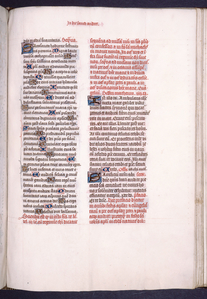Pricking:
Scribes would then page through the quires, pricking and ruling the leaves as necessary in order to achieve straight, even script. Pricking was generally done on the outer edges of a leaf, and if not trimmed off in the final stages of manuscript creation, was still generally visible in the finished copy. The pricking could be done using a variety of tools; most commonly used were knives, awls, or compasses; knives would leave "small slits in the parchment," where awls or compasses would leave "rounded holes" (Graham and Clemens 15). As the pricking was intended to be a guide for the ruling, which was to ensure level script, the holes of the pricking needed to be evenly spaced and aligned. To this end, scribes would frequently "place a ruler" in the margin of the leaf and bring "the pricking instrument right up against, or close to, the ruler" in an attempt to achieve a straight alignment (Graham and Clemens 15). Multiple leaves were generally pricked at once, meaning the pricks were smaller and less noticeable on lower leaves. Pricking could be done before the sheets of parchment were folded into a pair of leaves or after. On Continental Europe, pricking was generally done before folding; on the British Isles, the folding was done first and the pricking was generally done afterward. Like the practice of quire arrangement, the scribes of the British Isles adjusted to the method of the Continent, pricking before the folding after the ninth century (Graham and Clemens 15). Pricking was also done in the upper and lower margins of the page as well as the exterior and interior, in order to establish vertical rulings for correct columnization of text.
To the left is a manuscript exhibiting pricking along the right-hand margin; the pricking was not removed during trimming of the leaves, and was likely done with an awl or compass due to the rounded nature of the pricks.





